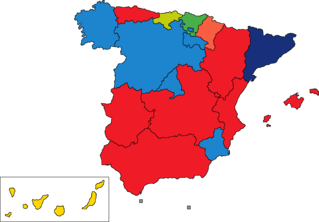This gallery of flags of the autonomous communities of Spain shows the distinctive flags of the 17 autonomous communities, plus the autonomous cities of Ceuta and Melilla.
This gallery of coats of arms of the autonomous communities of Spain shows the distinctive coats of arms of the 17 autonomous communities of Spain, plus the autonomous cities of Ceuta and Melilla.
The Segunda División B 2007–08 season was the 31st since its establishment. The first matches of the season were played on 25 August 2007, and the season ended on 15 June 2008 with the promotion play-off finals.

The political division of the Kingdom of Spain is defined in Part VIII of the Spanish constitution of 1978, which establishes three levels of territorial organization: municipalities, provinces and autonomous communities, the first group constituting the subdivisions of the second, and the second group constituting the subdivisions of the last. The State guarantees the realization of the principle of solidarity by endeavouring to establish an economic balance between the different areas of the Spanish territory.

The 2007 Spanish regional elections were held on Sunday, 27 May 2007, to elect the regional parliaments of thirteen of the seventeen autonomous communities—Aragon, Asturias, the Balearic Islands, the Canary Islands, Cantabria, Castile and León, Castilla–La Mancha, Extremadura, La Rioja, Madrid, Murcia, Navarre and the Valencian Community—, not including Andalusia, the Basque Country, Catalonia and Galicia, which had separate electoral cycles. 812 of 1,206 seats in the regional parliaments were up for election. The elections were held simultaneously with local elections all throughout Spain.

The 2011 Spanish regional elections were held on Sunday, 22 May 2011, to elect the regional parliaments of thirteen of the seventeen autonomous communities—Aragon, Asturias, the Balearic Islands, the Canary Islands, Cantabria, Castile and León, Castilla–La Mancha, Extremadura, La Rioja, Madrid, Murcia, Navarre and the Valencian Community—, not including Andalusia, the Basque Country, Catalonia and Galicia, which had separate electoral cycles. 824 of 1,218 seats in the regional parliaments were up for election. The elections were held simultaneously with local elections all throughout Spain.

The 2015 Spanish regional elections were held on Sunday, 24 May 2015, to elect the regional parliaments of thirteen of the seventeen autonomous communities—Aragon, Asturias, the Balearic Islands, the Canary Islands, Cantabria, Castile and León, Castilla–La Mancha, Extremadura, La Rioja, Madrid, Murcia, Navarre and the Valencian Community—, not including Andalusia, the Basque Country, Catalonia and Galicia, which had separate electoral cycles. 804 of 1,198 seats in the regional parliaments were up for election. The elections were held simultaneously with local elections all throughout Spain.

The 2003 Spanish regional elections were held on Sunday, 25 May 2003, to elect the regional parliaments of thirteen of the seventeen autonomous communities—Aragon, Asturias, the Balearic Islands, the Canary Islands, Cantabria, Castile and León, Castilla–La Mancha, Extremadura, La Rioja, Madrid, Murcia, Navarre and the Valencian Community—, not including Andalusia, the Basque Country, Catalonia and Galicia, which had separate electoral cycles. 792 of 1,186 seats in the regional parliaments were up for election. The elections were held simultaneously with local elections all throughout Spain.

The 1983 Spanish regional elections were held on Sunday, 8 May 1983, to elect the regional parliaments of thirteen of the seventeen autonomous communities—Aragon, Asturias, the Balearic Islands, the Canary Islands, Cantabria, Castile and León, Castilla–La Mancha, Extremadura, La Rioja, Madrid, Murcia, Navarre and the Valencian Community—, not including Andalusia, the Basque Country, Catalonia and Galicia, which had separate electoral cycles. 764 of 1,139 seats in the regional parliaments were up for election. The elections were held simultaneously with local elections all throughout Spain.

The 1987 Spanish regional elections were held on Wednesday, 10 June 1987, to elect the regional parliaments of thirteen of the seventeen autonomous communities—Aragon, Asturias, the Balearic Islands, the Canary Islands, Cantabria, Castile and León, Castilla–La Mancha, Extremadura, La Rioja, Madrid, Murcia, Navarre and the Valencian Community—, not including Andalusia, the Basque Country, Catalonia and Galicia, which had separate electoral cycles. 779 of 1,169 seats in the regional parliaments were up for election. The elections were held simultaneously with local elections all throughout Spain, as well as the 1987 European Parliament election.
A provincial deputation is the governing body of a province of Spain.

This is the results breakdown of the European Parliament election held in Spain on 25 May 2014. The following tables show detailed results in each of the country's 17 autonomous communities and in the autonomous cities of Ceuta and Melilla.

This is the results breakdown of the European Parliament election held in Spain on 7 June 2009. The following tables show detailed results in each of the country's 17 autonomous communities and in the autonomous cities of Ceuta and Melilla.

The 1991 Spanish regional elections were held on Sunday, 26 May 1991, to elect the regional parliaments of thirteen of the seventeen autonomous communities—Aragon, Asturias, the Balearic Islands, the Canary Islands, Cantabria, Castile and León, Castilla–La Mancha, Extremadura, La Rioja, Madrid, Murcia, Navarre and the Valencian Community—, not including Andalusia, the Basque Country, Catalonia and Galicia, which had separate electoral cycles. 784 of 1,178 seats in the regional parliaments were up for election. The elections were held simultaneously with local elections all throughout Spain.

This is the results breakdown of the European Parliament election held in Spain on 13 June 1999. The following tables show detailed results in each of the country's 17 autonomous communities and in the autonomous cities of Ceuta and Melilla.

The 1995 Spanish regional elections were held on Sunday, 28 May 1995, to elect the regional parliaments of thirteen of the seventeen autonomous communities—Aragon, Asturias, the Balearic Islands, the Canary Islands, Cantabria, Castile and León, Castilla–La Mancha, Extremadura, La Rioja, Madrid, Murcia, Navarre and the Valencian Community—, not including Andalusia, the Basque Country, Catalonia and Galicia, which had separate electoral cycles. 786 of 1,180 seats in the regional parliaments were up for election. The elections were held simultaneously with local elections all throughout Spain.

The 1999 Spanish regional elections were held on Sunday, 13 June 1999, to elect the regional parliaments of thirteen of the seventeen autonomous communities—Aragon, Asturias, the Balearic Islands, the Canary Islands, Cantabria, Castile and León, Castilla–La Mancha, Extremadura, La Rioja, Madrid, Murcia, Navarre and the Valencian Community, not including Andalusia, the Basque Country, Catalonia and Galicia, which had separate electoral cycles. 784 of 1,178 seats in the regional parliaments were up for election. The elections were held simultaneously with local elections all throughout Spain, as well as the 1999 European Parliament election.

The 2019 Spanish regional elections will be held on Sunday, 26 May 2019, to elect the regional parliaments of twelve of the seventeen autonomous communities—Aragon, Asturias, the Balearic Islands, the Canary Islands, Cantabria, Castile and León, Castilla–La Mancha, Extremadura, La Rioja, Madrid, Murcia and Navarre—, not including Andalusia, the Basque Country, Catalonia, Galicia and—for the first time—the Valencian Community. 715 of 1,208 seats in the regional parliaments will be up for election. The elections will be held simultaneously with local elections all throughout Spain, as well as the 2019 European Parliament election.























